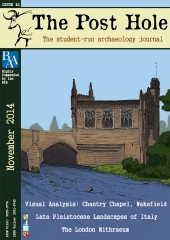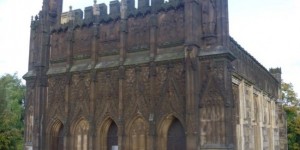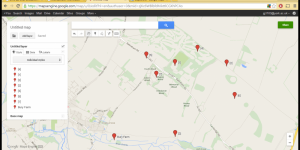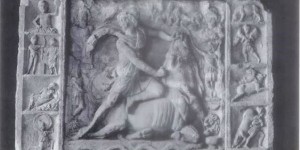As I am delving deeper into bio-archaeology, arguably the most rapidly advancing sub-discipline of archaeology, I am becoming more aware of the importance of the multidisciplinary approach to archaeological study. Through conversations with peers, I have found that archaeology tends to be a subject either stumbled upon or one which advocates are born into. If you take into consideration the wide scope of opportunities the discipline can offer and the various specialist techniques and skills that are required to complete a fully comprehensive archaeological study, this strikes me as rather strange. It seems that the general public consensus is that a day as an archaeologist either consists of sitting in a mud hole in the ground, or raiding ancient tombs and trying to avoid the inevitable onslaught of the cursed treasure’s protector! The fact is that the field has moved on from the days of using dynamite to excavate, as the Victorians did, or other equally inapt techniques (in most cases, anyway), and today it is more diverse than ever before. There are opportunities for: field archaeologists, commercial archaeologists, bioarchaeologists, GIS teams, bio-mathematicians, historical interpreters, heritage workers, maritime archaeologists, archaeological photographers, metal detectorists, post-ex analysts, landscape archaeologists, and the list could go on. In my opinion, this is the obvious attraction of archaeology: whether you’re interested in the demission of Homo neanderthalensis or the contents of a public rubbish bin, there is a space for all those interested in understanding the human past by assessing what we leave behind. This is why I think it is so important that archaeological researchers, no matter which sub-discipline they may be part of, are archaeologists first and foremost. The background knowledge of the wider picture normally results in far more comprehensive studies and research is more focused and relevant when put into context. This is something we can lose when we hand over our samples to a non-archaeologist. I am not criticising other disciplines, but merely questioning the importance of the results when data is analysed without the archaeological value of these results in mind. A multidisciplinary study does not mean throwing all forms of analysis at a site or sample, but logically thinking through the best ways to address specific archaeological questions using techniques from a range of fields of study.
Last month I briefly mentioned the new TPHExtra feature ‘TPH meets York Seminars’ and it may not seem like a lot has happened since then. However, behind the scenes we have been recruiting a new team of interviewers headed up by Zack Goodall, our Publicity Coordinator. We have now filmed four interviews with Paul Pettitt, Barry Taylor, Jane Grenville and Huw Barton, which are in the process of being edited and will soon be released on our website. Here are some comments from two of our interviewers about the process and meeting the interviewees themselves:
Emma Samuel “Dr Taylor is known for his work at Star Carr, the world renowned early Mesolithic site in North Yorkshire. This interview provided a rare opportunity to pick his brains on subjects ranging from palaeoecology to ethnography. It was also a chance to learn more about his research into animate landscapes, specifically the relationship between people and plants.
For anyone interested in delving deeper into this subject area, Dr Taylor is co-hosting a session at TAG Manchester this year.”
Freya Lawson-Jones “Dr Huw Barton, a guest speaker at York from the University of Leicester, came to lecture on the Penan people’s culture from Borneo as part of our weekly York Seminar Series. This fascinating talk looked at the relationship between people and plants in this part of the world, raising many interesting questions about what relationships of this nature there may have been in the past. In this interview, we covered Dr Barton’s work on the Cultured Rainforest Project, as well as in the Great Cave of Niah and lots more.”
The Post Hole image competition is still open! We are looking for a cover image for an issue next year, so please send in your photographs, digital images and reconstructions from the excavation season. Find out more and enter on our competition page.
We would love to hear your opinions or any extra information you have concerning the topics of the articles featured in this Issue. Please send them in a ‘Letter to the Editor’. Visit our Letter to the Editor page and fill in the relevant details on the form. This is another opportunity to get involved, so please do not miss the chance to have your views published by The Post Hole.
Before we move on to this month’s articles, I would like to send out a call for PR Officers. We are looking for people all across the world to become PR Officers and advertise The Post Hole in their establishment (individuals will be fully credited for their efforts). If you are interested in this opportunity please email Eleanor via editor [at] theposthole.org.
Now to the articles featured in Issue 41. The first article comes from Ben Wajdner, who assesses the current methods of heritage management and offers a well researched alternative. This work has been carried out as part of Wajdner’s MA thesis, so if you like the article please take a look at his Academia page: http://york.academia.edu/BenWajdner.
The second article concerns the Pleistocene landscape of Central Italy. Maurizio Gatta presents findings from Cisterna di Latina as an example of how a mixture of techniques are changing how we think of this ancient landscape.
Joanne Harrison is the author of the third article this month. Harrison has produced some interesting images by visually analysing Chantry Chapel in Wakefield, and she summarizes the development and redevelopment of the Chapel, from the Medieval construction to minor restoration works in the 21st century.
The fourth interesting paper comes from James Green and concerns the recent excavations going on a Bury Farm. Green assesses the importance of the site when considering the surrounding landscape. The author also stresses the importance of engaging with the local community during projects such as this.
The fifth and final article of the November issue is written by Chase Minos and concerns the religious phenomenon, the cult of Mithras. Minos scrutinises inscriptions and temples looking for evidence of the cult, whilst examining the involvement of the Roman military.
I hope you enjoy the variety of the research papers submitted for Issue 41. If you would like to feature in an upcoming issue of The Post Hole, please send in your work in a word document to Jess (submissions [at] theposthole.org). If you need any advice or have any questions please send an email (again to submissions) and we will be happy to help. More information on submissions, formatting and referencing can be found on our Information for Authors page.
I would finally like to express my gratitude to Alicyn Murphy for the fantastic drawing of Chantry Chapel in Wakefield which features as our Cover Art this month.
All the best,
Eleanor Green.
Editor-in-Chief
editor [at] theposthole.org







